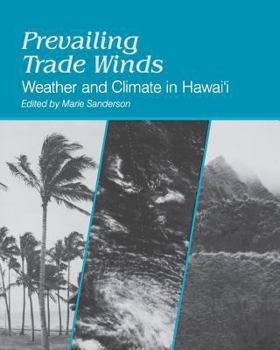Prevailing Trade Winds: Weather and Climate in Hawai'i
The Hawaiian Islands are small in area, but they resemble continents in miniature with climates ranging from tropical rainforest to desert to tundra. Prevailing Trade Winds: Weather and Climate in Hawaii, intended for students of geography, biology, ecology, and hydrology, for visitors interested in the natural phenomena of the places they visit, and for island residents, explains in clear language the many aspects of the climate and weather of Hawaii. Weather is usually defined as the current state of the atmosphere, while climate denotes average weather and includes the variability and frequency of the factors that produce weather. The authors of this volume discuss the factors that control climate; the radiation, energy, and water balances; the impact of climate on human activity; the climate-related meanings of many place names in Hawaii; and the importance of the climate of Hawaii for scientific research. Contributors: Paul Ekern, Tom Giambelluca, Dennis Nullet, Saul Price, Marie Sanderson, and Thomas Schroeder.
Format:Paperback
Language:English
ISBN:0824814916
ISBN13:9780824814915
Release Date:February 1994
Publisher:University of Hawaii Press
Length:156 Pages
Weight:0.75 lbs.
Dimensions:0.4" x 7.9" x 9.2"
Customer Reviews
1 rating
It isn't all paradise
Published by Thriftbooks.com User , 17 years ago
There once was a radio announcer in Honolulu who gave the same forecast all the time. Even when it was pouring, she would predict, "It will be a nice, sunny day." Her predictions were not very useful but they were accurate 85% of the time, which is a lot better than the National Weather Service average. The researchers represented in "Prevailing Trade Winds" exploit the same contradiction in island weather that the announcer did: Overall it is wonderful and changes comparatively little, while on a small scale it varies almost yard by yard. As a result, the Hawaiian islands are an excellent natural laboratory, "climatically . . . resembling continents in miniature." In such a short volume, "Prevailing Trade Winds" does not pretend to be comprehensive. Rather, it presents representative examples of weather phenomena, such as the Maui Vortex. The vortex, first identified by the Pineapple Research Institute from photographs of the central valley, is a swirl created by the trades blowing between two mountains. Wind that starts in the east speeds up and ends by sweeping down on the west coast of the island from a more northerly angle. This is of practical interest because of the dryness of the central valley. Few people, residents or tourists, realize that central Maui is the driest place in the state, as dry as Kawaihae on the Big Island, which looks like a desert. Only irrigation supports the waving green sugar cane and suppresses the dust storms that otherwise would make Kihei uninhabitable. Ignorance about local weather can be costly elsewhere, too. "Potential wind damage . . . is seldom a design criterion for Hawaiian houses. Structural failure due to wind is considered too unlikely to justify reinforcing houses for high wind," says Thomas Schroeder in a chapter on "Climate Controls." This might already have been changing when this book was published in 1994, shortly after Hurricane Iniki wrecked Kauai. "Prevailing Trade Winds" is full of fascinating tidbits. For example, although Waialeale, Kauai, is usually described as the rainiest place in the world, the one-month official record for the United States, 107 inches, was recorded at Puu Kukui, West Maui. It also has some bad information. Several references to wind power installations are out of date, and the statement that "most scientists agree that increased concentrations of the greenhouse gases will shift the Earth's radiation balance toward global warming" was incorrect in 1994, when a large majority of American climatologists (the "Phoenix group") went on record rejecting this idea. It is still incorrect in 2008. Which is not to say nothing is happening. "Dramatic climate changes have occurred in Hawaii in the past 5,000 to 10,000 years," Paul Ekern reminds us in the chapter on "Climate and Human Activity."






